Fossil of 2022
Large inoceramid bivalves characterize the Late Cretaceous on a global scale. The impetus for increased growth in size evidently came in the late Turonian, about 91 million years ago, when large representatives of the species Inoceramus stuemckei suddenly appeared. The reason for this was increased pressure from shell-breaking marine predators (sharks, mosasaurs, lobster-like crabs), which the mussels living on the sea floor countered by increasing their size and strengthening their shells and hinges. This predator-prey escalation is – in addition to taxonomic and stratigraphic questions – the subject of the work of Niebuhr & Wilmsen (2022).
Niebuhr, B. & Wilmsen, M. (2022): Large-sized Late Turonian–Early Coniacian (Late Cretaceous) inoceramid bivalves from Germany: taxonomic issues, temporal framework and palaeoecological implications. – Paläontologische Zeitschrift: 27 pp.; Stuttgart. https://doi.org/10.1007/s12542-022-00615-9
Revisions
The first and the second part of the revision of the Cretaceous fauna of Saxony already have been published. Part 3 will follow …
NIEBUHR B. & WILMSEN M. (2014, Eds.): Kreide-Fossilien in Sachsen, Teil 1. – Geologica Saxonica 60(1): 1–254; Dresden.
NIEBUHR B. & WILMSEN M. (2016, Eds.): Kreide-Fossilien in Sachsen, Teil 2. – Geologica Saxonica 62: 1–245; Dresden.
All articles are available in open access here.
New publications 2022
Löser, H. & Wilmsen, M. (2022): Lower Cenomanian (Cretaceous) corals from Cóbreces (Santander, Cantabria, Spain) – Introduction and superfamilies Actinastreoidea, Amphiastreoidea, and Caryophyllioidea. – Neues Jahrbuch für Geologie und Paläontologie, Abhandlungen, 303: 203–218; Stuttgart.
Niebuhr, B. & Wilmsen, M. (2022): Large-sized Late Turonian–Early Coniacian (Late Cretaceous) inoceramid bivalves from Germany: taxonomic issues, temporal framework and palaeoecological implications. – Paläontologische Zeitschrift: 27 pp.; Stuttgart. https://doi.org/10.1007/s12542-022-00615-9
Salehi, M.A., Wilmsen, M., Zamanian, E., Baniasad, A. & Heubeck, C. (2022): Depositional and thermal history of a continental, coal-bearing Middle Jurassic succession from Iran: Hojedk Formation, northern Tabas Block. – Geological Magazine: 25 pp.; DOI: https://doi.org/10.1017/S0016756822000814
Scheiblhofer, E., Moser, U., Lӧhr, S., Wilmsen, M., Farkaš, J., Gallhofer, D., Bäckström, A.M., Zack, T. & Baldermann, A. (2022): Revisiting glauconite geochronology: Lessons learned from in situ radiometric dating of a glauconite-rich Cretaceous shelfal sequence. – Minerals, 12: 818. https://doi.org/10.3390/min12070818
Wilmsen, M., Fürsich, F.T. & Majidifard, M.R. (2022): Youngest Cretaceous dinosaur tracksite from the Middle East (Maastrichtian, Farrokhi Formation, Central Iran). – Palaeobiodiversity and Palaeoenvironments, 102:437–447; DOI 10.1007/s12549-021-00516-w
Wilmsen, M., Niebuhr, B. & Kennedy, W.J. (2022): Middle Cenomanian ammonites from the Oberhäslich Formation (Elbtal Group, Germany): stratigraphic and palaeogeographic implications for the Saxo-Bohemian Cretaceous. – Neues Jahrbuch für Geologie und Paläontologie, Abhandlungen 303(3): 271–294; Stuttgart.



